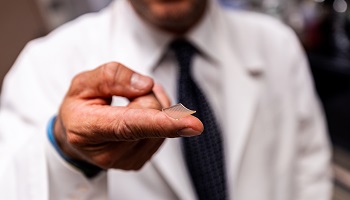Pitt researchers unveil potential COVID-19 vaccine

PittCoVacc, the potential vaccine against COVID-19. Photo via UPMC
April 2, 2020
Pitt School of Medicine scientists announced Thursday that they had developed a potential vaccine against COVID-19.
The vaccine has so far been tested on mice and produced antibodies specific to the coronavirus “at quantities thought to be sufficient for neutralizing the virus,” according to a press release.
UPMC scientists have named the vaccine PittCoVacc, short for Pittsburgh Coronavirus Vaccine. When tested in mice, PittCoVacc generated a surge of antibodies against COVID-19 within two weeks of the microneedle prick. Researchers are comparing the antibody levels to that of developments for vaccines against the MERS coronavirus, which follow a similar trend.
“Importantly, the SARS-CoV-2 microneedle vaccine maintains its potency even after being thoroughly sterilized with gamma radiation — a key step toward making a product that’s suitable for use in humans,” the release said.
The UPMC study describing the scientists’ methods was published Thursday in the open-access medical journal EBioMedicine following critiques from fellow scientists at outside institutions. The release said researchers were able to act quickly because they already had created a foundation for the research during earlier coronavirus epidemics.
“We had previous experience on SARS-CoV in 2003 and MERS-CoV in 2014. These two viruses, which are closely related to SARS-CoV-2, teach us that a particular protein, called a spike protein, is important for inducing immunity against the virus. We knew exactly where to fight this new virus,” co-senior author Andrea Gambotto, M.D., associate professor of surgery at the Pitt School of Medicine, said in the release.
The authors of the UPMC study are now in the process of applying for an investigational new drug approval from the U.S. Food and Drug Administration in anticipation of starting a phase I human clinical trial in the next few months.
“Testing in patients would typically require at least a year and probably longer,” co-senior author Louis Falo, M.D., Ph.D., professor and chair of dermatology at Pitt’s School of Medicine and UPMC, said in the release. “This particular situation is different from anything we’ve ever seen, so we don’t know how long the clinical development process will take. Recently announced revisions to the normal processes suggest we may be able to advance this faster.”
PittCoVacc uses lab-made pieces of viral protein to build immunity, similar to how current flu shots work. The researchers are also using a microneedle array in administering the vaccine to increase potency. The array is a fingertip-sized patch of 400 small needles, similar to a band-aid, that delivers the spike protein pieces into the skin, where the immune reaction is strongest. The needles, made of sugar and protein pieces, simply dissolve into the skin.
“We developed this to build on the original scratch method used to deliver the smallpox vaccine to the skin, but as a high-tech version that is more efficient and reproducible patient to patient,” Falo said. “And it’s actually pretty painless — it feels kind of like Velcro.”
Scientists also took manufacturing into account when constructing the potential vaccine. The protein pieces in the vaccine can be multiplied easily and purified at industrial scale. Once manufactured, the microneedle array can sit at room temperature until it is needed, eliminating the need for refrigeration.


